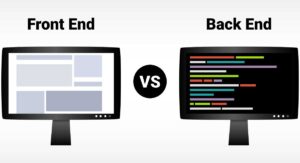Interview preparation is critical. If you’re ready for whatever a recruiter asks you, you will be more confident and have a greater chance of completing the interview. To that end, we present a collection of the most commonly asked software engineer interview questions, divided into beginner and experienced sections.
Although we can only anticipate some of the questions you may encounter, we include various technical interview questions software engineers could face.
Let’s begin by exploring what a software engineer does, then move on to the actual software engineer and software developer interview questions (and answers!). Finally, we will share an online full stack web developer program you can take to gain the knowledge and skills you need to back up your answers.
What Does a Software Engineer Do?
Software engineers apply their knowledge of programming languages and engineering principles to develop software solutions for end users, designing and developing business applications, operating systems, computer games, network control systems, and middleware.
The occupations of “software engineer” and “software developer” are frequently used interchangeably. However, software developers focus on writing specific scalable, efficient, and maintainable code, integrating APIs, building and maintaining database systems, etc. In contrast, software engineers plan, design, develop, and construct a whole software or computer system.
So, software development is, in fact, a part of the software engineering process. The software developers work with clients to determine their wants and lead the design implementation team. In contrast, software engineers build the needed systems.
Since the two positions share significant overlap, the following software engineer interview questions could be used to prepare for interviews for either job. We’re offering ten questions per skill level.
Also Read: What is Software Testing in Software Engineering?
Software Engineer Interview Questions for Beginners
- Name the primary software categories.
The categories are:
- Application software
- Artificial Intelligence software
- Embedded software
- Scientific software
- System software
- Web Applications
- What’s the primary difference between computer software and a computer program?
Computer programs are pieces of programming code that perform a well-defined task. Computer software includes programming code, plus all documentation and user guides.
- Define a framework
Frameworks are a popular method of developing and deploying software, consisting of tools that facilitate software development by providing information on how to build it on an abstract level instead of giving exact details.
- Name the six major software characteristics.
The six characteristics are:
- Functionality. The things that software is intended to do.
- Efficiency. The software can use the provided resources in the best ways possible. When you increase software efficiency, it improves resource utilization and consequently reduces cost.
- Reliability. The probability of failure-free operational software within an environment.
- Usability. This refers to the customer’s experience while using the software and determines user satisfaction.
- Maintainability. How easy it is to repair, improve, and understand the software code.
- Portability. The ease with which the software can be moved from one environment to another.
- What are the stages of the software development life cycle (SDLC)?
The stages are:
- Planning
- Requirements gathering and analysis
- Design
- Coding and implementation
- Testing
- Deployment
- Maintenance
Also Read: Understanding Front-end vs. Back-end Development: Career Guide 2024
- Name the different SDLC models and which is generally recognized as the best.
The SDLC models are:
- Agile Model
- Big bang model
- Incremental model
- Iterative model
- Spiral model
- Waterfall model
Agile is generally considered the best SDLC model and is most often used in the IT industry since it’s a fusion of incremental and iterative approaches that are especially well-suited for flexible environments.
- What does CASE stand for, and what are the different CASE tools?
CASE stands for Computer-AidedSoftware Engineering. The tools are:
- Code Generation Tool
- Document Production Tool
- Requirement Analysis Tool
- Reverse Engineering Tool
- Structure Analysis Tool
- Software Design Tool
- Test Case Generation Tool
- What are the advantages of the incremental model?
The advantages are:
- It can deliver iterations faster
- Development occurs in parallel to each other
- Developers can reduce the initial delivery cost by using this model
- The client or user can provide feedback at every level, which helps minimize unexpected requirement changes
- Developers can identify and manage risks on a module-by-module basis
- Explain verification and validation.
Verification is the process of ensuring the software accomplishes its objectives without defects. It determines if the product being developed is correct or not and whether it meets specifications. Verification is mainly focused on functionality. On the other hand, validation determines whether the software meets the required standards or, put another way, whether the software meets the product’s established quality criteria.
- Explain prototyping and POC.
A prototype is a working model of the software but with limited functionality. The prototype may contain the logic used in the final software program and, consequently, is an additional work that must be considered in the calculation. Users can use prototyping to review and test the developer’s proposals before implementation. Prototyping also aids in comprehending user-specific details that the developer may have otherwise missed during the product development stage. On the other hand, Proof of Concept (or POC) is a method used to validate a concept or idea’s practicality. This stage occurs before the beginning of the software development process. A mini project is built based on technical capability and business model to see if a concept can be executed.
Also Read: All About the Software Development Life Cycle
Software Engineer Interview Questions for Experienced Professionals
- What is a feasibility study in the context of software engineering?
A feasibility study measures software products regarding how helpful product development will be for the organization from a practical standpoint. Feasibility studies are done for many reasons, including determining if a software product is appropriate regarding development, implementation, and project value to the company. Feasibility studies concentrate on these areas:
- Economic feasibility
- Technical feasibility
- Operational feasibility
- Legal feasibility
- Schedule feasibility
- What are black box and white box testing?
Black box testing is a method of high-level testing with a primary goal of evaluating functionalities from a behavioral standpoint. The tester doesn’t test the code but uses the program to see if it functions as expected. You perform white box testing when you have insights into the code or broad information about the software’s architecture. It’s also known as clear box testing and falls under the classification of low-level testing. White box testing is mainly concerned with integration and unit testing and requires programming expertise or at least a solid grasp of the code used to implement a particular functionality.
- Define concurrency.
Concurrency describes a set of mechanisms and techniques that let the software perform many tasks simultaneously. Developers can achieve concurrency using languages like C++ or Java since these languages support the thread concept. You must have new hardware and software features to achieve concurrency.
- What are software metrics, and what are they suitable for?
Software Metrics are quantitative measures of program properties that can be utilized for an extensive range of things like analyzing software performance, planning, estimating productivity, etc. Software metrics include code complexities, load testing, average failure rate, stress testing, lines of code, etc. The benefits of software metrics include:
- Cost reduction
- Increased ROI (return on investment)
- Reduced workloads
- Highlights areas for improvement
- What is adaptive maintenance?
Adaptive maintenance is the modifications and updates a customer needs to run the product on new platforms, operating systems, hardware, or applications.
- What’s a Level-0 Data flow diagram?
The highest abstraction level of the DFD is called Level 0, but it is also called context level DFD. This displays the entire information system as one diagram.
Also Read: What Does a Coder Do? A Beginner’s Guide
- What distinguishes quality assurance from quality control?
Quality assurance checks if the correct processes are followed while developing software, while quality control deals with maintaining the software product’s quality. Quality assurance is preventative; quality control is corrective.
- Explain software configuration management.
Software Configuration Management (SCM) occurs during the Software Development Life Cycle and is a method of systematically managing, organizing, and controlling changes in code, documents, and other entities. Its primary purpose is to enhance production while making as few errors as possible.
- What’s the difference between cohesion and coupling?
Cohesion describes relationships within modules, and increased cohesion is ultimately good for software. Coupling describes the relationships between modules and should be avoided.
- What does OSI stand for, and what are its model layers?
OSI stands for Open Systems Interconnection (OSI). Its model layers are:
- Physical, which transmits raw bit data over a physical medium
- Data Link, which defines the data format
- Network, which defines the physical path for the data
- Transport and transmit data using protocols
- Session, responsible for ports and session control
- Presentation, displaying data in a usable format
- Application, enabling human-computer interaction
- SPECIAL BONUS SOFTWARE DEVELOPER INTERVIEW QUESTION: List some essential code quality tools you’ve worked with.
Recruiters want to know what kind of experience you have with software engineering and development applications. Here’s a list of some of the most popular ones. Make sure you familiarize yourself with some of them before interviewing.
- Codacy
- Crucible
- DeepScan
- DeepSource
- Embold
- PVS-Studio
- SonarQube
- Upsource
- Veracode
How to Prepare for a Software Engineer Interview
- Research the company. Conduct research and learn about the position, including expectations, challenges, and likely projects. Interviewers like it when they see that the candidates have gotten acquainted with the organization.
- Match your skills to the job requirements. Prepare answers to interview questions that highlight the skills that the employer needs.
- Give examples of your achievements. Call out noteworthy accomplishments that will show employers examples of how your past performances yielded successful results.
- Make a list of questions for YOU to ask. Interviewers often give applicants a chance to ask questions after the interview. Use this time to ask insightful questions about the position, including what’s expected of you, possible learning/training opportunities, etc.
Do You Want to Learn About Full Stack Web Development?
Full-stack web developers share common ground with software engineers and developers. Full stack development involves creating an application from the front end (users) to the back end (systems) and is a highly sought-after profession. If you’d like full stack web development training, consider enrolling in this web development bootcamp.
This intense, 9-month program teaches you the necessary full stack development skills and AI topics, such as generative AI and prompt engineering, while helping you build your own Git portfolio. According to Indeed.com, full-stack web developers earn an annual salary of $123,900. Sign up for this highly instructive bootcamp and secure the skills needed for an exciting new career. Most importantly, be assured that you can ace software engineer interview questions!
You might also like to read:
Full Stack Developer Salaries: Here’s The Latest Buzz
2024 Full Stack Developer Roadmap: A Comprehensive Guide
What Do Coders Do and What Kind of Coder Salary Can You Expect?






